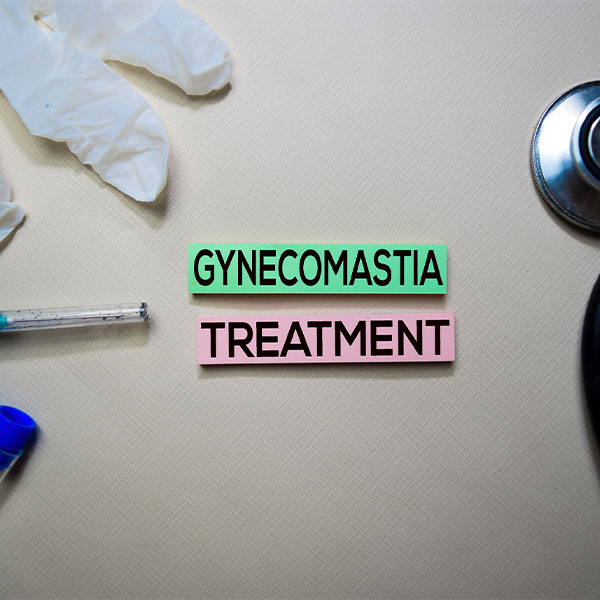Gynecomastia Treatments Available Today
Before discussing cosmetic solutions and gynecomastia treatments available today, we need to look at the underlying causes. Your surgeon will need to address your medical history to ensure that cosmetic surgery is the right solution.
Diagnosis
A diagnosis of gynecomastia requires a review of your symptoms and a medical exam. The exam includes carefully evaluating breast tissue and the abdomen. In some cases, the exam may include consideration of gonad-related issues.
Gynecomastia can be caused by:
- Hereditary
- Testosterone hormone fluctuations
- A host of medications
- Recreational drug use, which includes alcohol and anabolic steroids
- Aging
- Certain health conditions (least common)
Tests
In extreme cases of gynecomastia, when there are indications of underlying issues, our doctor may order tests to identify possible causes before the patient can have gynecomastia treatments. These may include:
- Blood tests
- Non-routine
- Mammograms
- Computerized tomography (CT) scans
- Magnetic resonance imaging (MRI) scans
- Testicular ultrasounds
- Tissue biopsies
Conditions That Cause Similar Symptoms
Your doctor will want to ensure that your breast enlargement is gynecomastia and not another condition. Other conditions that present similar symptoms may include:
Fatty breast tissue (pseudogynecomastia)
Some men and boys, especially those who are obese, have breast fat that resembles gynecomastia. This excess fat isn’t the same as gynecomastia and doesn’t need additional evaluation. Liposuction may be a possible treatment for this excess fatty tissue.
Breast cancer
Breast cancer is relatively uncommon in men but can occur. Enlargement of a single breast or the presence of a firm nodule raises the concern for male breast cancer.
A breast abscess
An abscess is an infection of the breast tissue.
Let’s Discuss Your Options For Cosmetic Solutions
First, Is Gynecomastia Treatments Necessary?
Many cases of gynecomastia resolve without gynecomastia treatments, but some cases are persistent.
If you’re under gynecomastia treatments or taking any medications that may cause gynecomastia, your doctor may suggest stopping them or substituting them for another medication.
In adolescents with no underlying cause of gynecomastia other than regular hormone changes during puberty, your doctor may recommend periodic reevaluations every few months to see if the condition improves. Gynecomastia in adolescents often goes away without any gynecomastia treatments in less than two years.
Treatment may be necessary if the gynecomastia doesn’t improve or if it causes pain, tenderness, or embarrassment.

Medications To Treat Gynecomastia
Medications used to treat breast cancer may be helpful for some men with gynecomastia. They include:
- Tamoxifen (Soltamox)
- Aromatase inhibitors, such as anastrozole (Arimidex)
Although the Food and Drug Administration approves these medications, they have not been explicitly approved for use in people with gynecomastia.
Surgery To Remove Excess Breast Tissue
Even after initial treatment with medications, your doctor may recommend surgery if your enlarged breasts are significant and bothersome.
Three gynecomastia surgery options are available:
- Liposuction. This surgery removes excess breast fat but not the breast glandular tissue.
- Mastectomy. This surgery removes the breast gland tissue. The surgery is frequently done using only small incisions. This less invasive type of surgery requires less recovery time.
- Combination Liposuction and Mastectomy are recommended for some patients with fatty and protruding nipples.
Coping And Support
For men, enlarged breasts can be stressful and embarrassing. Gynecomastia can be challenging to hide in clothing and present challenges to romantic relationships.
During puberty, gynecomastia can make boys an easy target for teasing. It can make certain activities such as swimming or changing in locker rooms traumatic.
Whatever your age, you may feel your body has betrayed you. You may feel unhappy with yourself. These feelings are normal. To help you cope, you can reach out to XSculpt and connect with Dr. Adajar for an expert opinion.
Cost Of Gynecomastia Surgery
The average cost of gynecomastia surgery in Chicago ranges between $5,000 and $10,000. This price range is highly dependent on the severity and complexity of your case. These ranges are a portion of the overall cost. It does not cover anesthesia, operating room amenities, or other related costs.
What’s Next?
Please review our page for more detailed information on gynecomastia.
We offer consultations in-office and virtually. To schedule yours and establish the total cost of a personalized surgical plan, don’t hesitate to contact us at XSculpt.

GET YOUR COMPLIMENTARY ANALYSIS AND CONSULTATION TODAY
XSCULPT was founded by two award-winning board-certified surgeons Dr. Marc Adajar & Dr. Anh-Tuan Truong. Our practice specializes in body contouring procedures, including Gynecomastia (Male Breast Reduction), Abdominal Etching, Lipo 360, Vaser Hi Definition Liposuction, Male Puffy Nipple Reduction, Male Tummy Tuck, and Non-Surgical Fat Reduction. Medical services include Hormone & Testosterone Replacement Therapy, Anti-Aging, Peptide Therapy and Medical Weight Loss.
